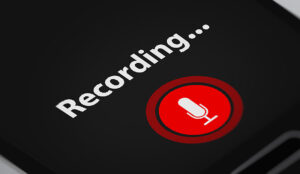Call recording provides a wealth of opportunity for businesses, most notably for call centre performance management, quality assurance, customer intelligence, compliance, and risk mitigation. Recorded audio can be mined to distill critical insight which empowers each of these areas.
A recorded interaction of both voice and screen, for example, can uncover workflow breakdowns that cause longer average handle times (AHT). Another recording might show an agent who is not properly complying with government regulations like GDPR, TSR, PCI, etc.
Yet another could uncover important competitor information that could impact sales or marketing campaigns.
All these benefits come from recorded conversations. However, like just about everything in business, timing is everything. Some of these insights are most valuable when discovered as the call unfolds. If a customer is indicating defection behavior, it can be too late to save the customer after the call ends. Likewise, a potentially costly dispute needs to be dealt with right away.
As such, there are two types of call recording/audio capture methodologies to consider:
Real-Time Audio Capture
Live audio streaming is captured as the conversation takes place in real time. When an AI-powered speech analytics solution is also deployed, the recorded audio is streamed right to the transcription and analytics engines to distill critical insight as the conversation unfolds.
Triggers can be set to alert supervisors immediately when a compliance infraction occurs or when a customer utters the words “cancel” or “unhappy”, for instance. The proper mitigation or action can then take place while the call is still live.
Post-Call Audio Capture
Some insights aren’t as time sensitive as others, yet they still provide ample value after the call has concluded. These areas can include the discovery of product update recommendations, for example, or information about a competitor, or even evidence to settle a discrepancy with a customer.
Some evidence can even be used in court. Still invaluable to a business, these insights can be gleaned after the conversation ends and still provide supervisors and management with actionable intelligence they can use to make improvements and mitigate risk.
Do You Need Real-Time or Post-Call Audio Capture?
Real-time audio capture is only valuable if someone or something (transcription and speech analytics, e.g.) is listening as the call takes place. Otherwise, post-call recording will suffice, as you wouldn’t be taking full advantage of its real-time, immediate value.
Here are a couple key questions to ask yourself to determine which recording solution makes the most sense for your business:
1. Which of the Following Areas Are Most Important to Your Contact Centre Right Now?
- Customer defection (real-time recording is best)
- call centre agent performance management (post-call recording will suffice, but real-time recording enables supervisors to make corrections immediately)
- Product insight (post-call recording will suffice)
- Regulatory compliance (post-call recording will suffice, but real-time recording enables supervisors to make corrections immediately)
- Dispute resolution (post-call recording will suffice, but real-time recording enables supervisors to make corrections immediately)
2. Do You Have Conversation Analytics Installed or Are You Planning to Deploy It?
Real-time streaming audio recording can feed a conversation intelligence engine as the call unfolds and provide invaluable insight that can be used immediately to drive service improvements, save a defecting customer, or mitigate dispute or compliance risk, for instance.
AI-powered analytics can automatically score your calls and identify the most impactful insight for immediate business improvement.
Further, with real-time recording and speech analytics, you can trigger immediate attention and next-best action based on the most impactful customer indicators with automatic data-driven intelligence.
AI-powered real-time analytics is revolutionizing how omnichannel customer service organizations operate today, and it is all driven by real-time audio capture. Is it time for you to invest in real-time recording?
This blog post has been re-published by kind permission of CallMiner – View the Original Article
For more information about CallMiner - visit the CallMiner Website
Call Centre Helper is not responsible for the content of these guest blog posts. The opinions expressed in this article are those of the author, and do not necessarily reflect those of Call Centre Helper.
Author: CallMiner
Published On: 10th Mar 2022 - Last modified: 15th Mar 2022
Read more about - Guest Blogs, CallMiner






 CallMiner is the leading cloud-based customer interaction analytics solution for extracting business intelligence and improving agent performance across all contact channels.
CallMiner is the leading cloud-based customer interaction analytics solution for extracting business intelligence and improving agent performance across all contact channels. 












